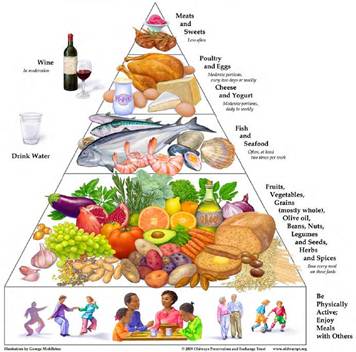It’s 2019 and we are still (and probably always will be) in the middle of a contradicting media storm about health and wellness.

Here’s the thing. There is always going to be a new, more trendy diet. At the end of the day, everyone is looking for that quick fix to lose weight or get in shape faster.
Throughout the decades…we’ve seen it all
1960’s: Vegetarianism
1970’s: Low calorie
1980’s: Low fat
1990’s: Low carb/High protein
2000’s: All-Natural food
Nowadays the market is hot for vegan, gluten-free, dairy-free, and soy-free products. But then again, Keto is taking over the world with its meat-centric diet. But then you have a body positivity movement where diets do not exist. Then there’s intermittent fasting where people will forgo food for several hours during their day.
The food industry has been sent into a flurry trying to meet all of these needs.
Health professionals are heavily scrutinized if they disagree with a trendy diet.
So…what should you do?
That’s easy, you should do what you want to do. I have been a dietitian long enough to know that you cannot spontaneously change your entire diet overnight. It takes time to identify the types of foods you like and that make you feel good about eating them. We all have different metabolic needs, we all break down and burn calories a little differently, and most importantly, we just like to eat different things.
Let’s break down some of the most popular diets/non-diet approaches to eating in 2019.
Ketogenic diet: This is a very low carb diet with high fat intake and moderate protein. It was first discovered in the 1920s and used as a treatment for children with Epilepsy. It is also being used in adults with epilepsy. One of the biggest side effects to the diet is weight loss. This side effect caught the attention of the general population and suddenly everyone was going “keto”. Here’s the thing though, this diet requires both physician and dietitian supervision along with routine blood labs and supplements. It takes a significant amount of time and calculating the nutrition composition of your meals. Therefore most of the people doing it, are probably doing it wrong. Which can be very dangerous for your cholesterol and overall health. Another thing to note, the ketogenic diet is used as a temporary treatment for epilepsy. This means most patients will end up back on a regular diet after a few years. Since the ketogenic diet is meant to be temporary, it is highly likely you will gain some, if not all of the weight back that you lost on keto. This diet should only be used when recommended by a physician or dietitian for a medical purpose.
Whole30: This is an elimination-style diet that bans all soy, dairy, grains, alcohol, legumes, and added sugars for 30 days straight. The premise of Whole30 is to “flush out your system”. You then slowly add in new foods by their group to determine which foods are affecting your system negatively. People that try this diet say they are able to cut back on foods that make them feel poorly after consuming them. Most will say they are more conscious of snacking on whole foods, like fruits and vegetables, instead of grabbing a candy bar. I think that is a definite pro to this diet. But I’ll tell you right now, there is no such thing as a “diet detox”. Your body is performing a detox every day by itself, your organs are great at doing that. Doing a juice cleanse or doing Whole30 isn’t going to make your body all of the sudden feel better.
Counting Macros: Macros or Macronutrients are how many grams of fat, protein, and carbohydrates you eat in a day. Rather than restricting foods, you aim to choose whole foods to meet your macronutrient requirements. The target macronutrient ratio for most people is 50% carbohydrates, 25% fat, and 25% protein. This range can change depending on your physical activity level, medical needs, height and weight, age, or fitness goals. It’s best to meet with a Registered Dietitian to get your customized needs calculated. From there, many macronutrient app calculators that make tracking your macros easy. This is great for people that like accountability and planning. I think it helps most people be more conscious of the nutrient composition of their food and encourages whole foods like fruits, vegetables, grains, meats, etc.
Intuitive Eating: This is a non-diet approach to eating. There are 10 principles involved and essentially you are relying on internal hunger cues. It’s not about meal planning, good foods or bad foods. It’s just eating. This style of eating is commonly recommended to people that have struggled with eating disorders. Since people with eating disorders have long histories of calorie counting, food avoidance, or binging and purging, this method of eating can help to avoid any of those triggers. This method of eating is best for those that have struggled with any disordered eating. Although, most people that intuitively eat, still have a general idea of how many calories are in the food they are consuming. You wouldn’t want someone with a chronic disease with little nutrition background to practice intuitive eating since a medically prescribed diet would be indicated.
Intermittent Fasting: This concept alternates a timeframe for eating with a timeframe for fasting. The most popular right now is the 16/8 method. This entails a 16 hour fast with an 8-hour window for eating. This method of eating does not restrict types of foods but restricts when you are actively eating. There are many other forms of intermittent fasting, some include eating just 500 calories for 2 days a week while eating normally the other 5 days. This diet should not be followed by anyone with a medical condition or with a history of eating disorders. The jury is still out on the effectiveness of this diet. I personally prefer to not limit my food intake for more than 4 hours at a time. I’m a hungry girl.
Meal Planning: Meal planning is essentially sitting down once or a few times per week to plan out and even cook your meals for the week. While this isn’t one particular diet, it’s a big concept within the health community. Meal planning can be done with many different diets and helps you to stick to portion sizes, prevents picking up take out on the way home, and is great for preventing any of your food going to waste. Many people find they eat more fruits and vegetables when they plan meals and snacks out ahead of time. This is great for the majority of people. In particular, if you like accountability, planning ahead, and saving money, then definitely try meal planning. This is something I do every week and it helps me spend less money on take out!
Mediterranean Diet: This diet was named the #1 diet for 2019. So what is it? Well, it’s actually a really great diet that focuses on heart-healthy fats (like olive oil), fruits, vegetables, grains, nuts and seeds, seafood, lean proteins and dairy, and even red wine. This diet was discovered many moons ago by Ancel Keys. He noted in the Seven Countries Study that countries around the Mediterranean sea had lower levels of cardiovascular disease. This Mediterranean diet was found to be a preventative for developing heart disease and is actually very easy to follow (and delicious). There are no calorie limits, just following the recommendations for increasing and limiting certain food groups is pretty much all that’s involved. Check out this guide below on the Mediterranean diet (note the recommended red wine).

So there you have it. All of these diets are different and some people may benefit from one more than another. Determining which is best depends on your medical history, personal preferences, and most importantly, what you really want to do.

I like that you’re a dietitian so you know what you’re talking about. I am educated and licensed as an acupuncturist. Another approach is the ethnographic method where you observe what different nations and cultures eat and emulate the people with the greatest longevity and least chronic degenerative disease. Japan and more specifically Okinawa is number 1. But beyond imitating other people is education. Nutrition is an endless subject, and the more educated you are the better off you are. That is what I am trying to say. Good article, experience shows through.
LikeLiked by 1 person
Really impressed. I have one similar topic on ‘Good eating habits’. Have a look
https://healthcarentsickcare.com/good-eating-habits
LikeLiked by 1 person
Will do!
LikeLiked by 1 person